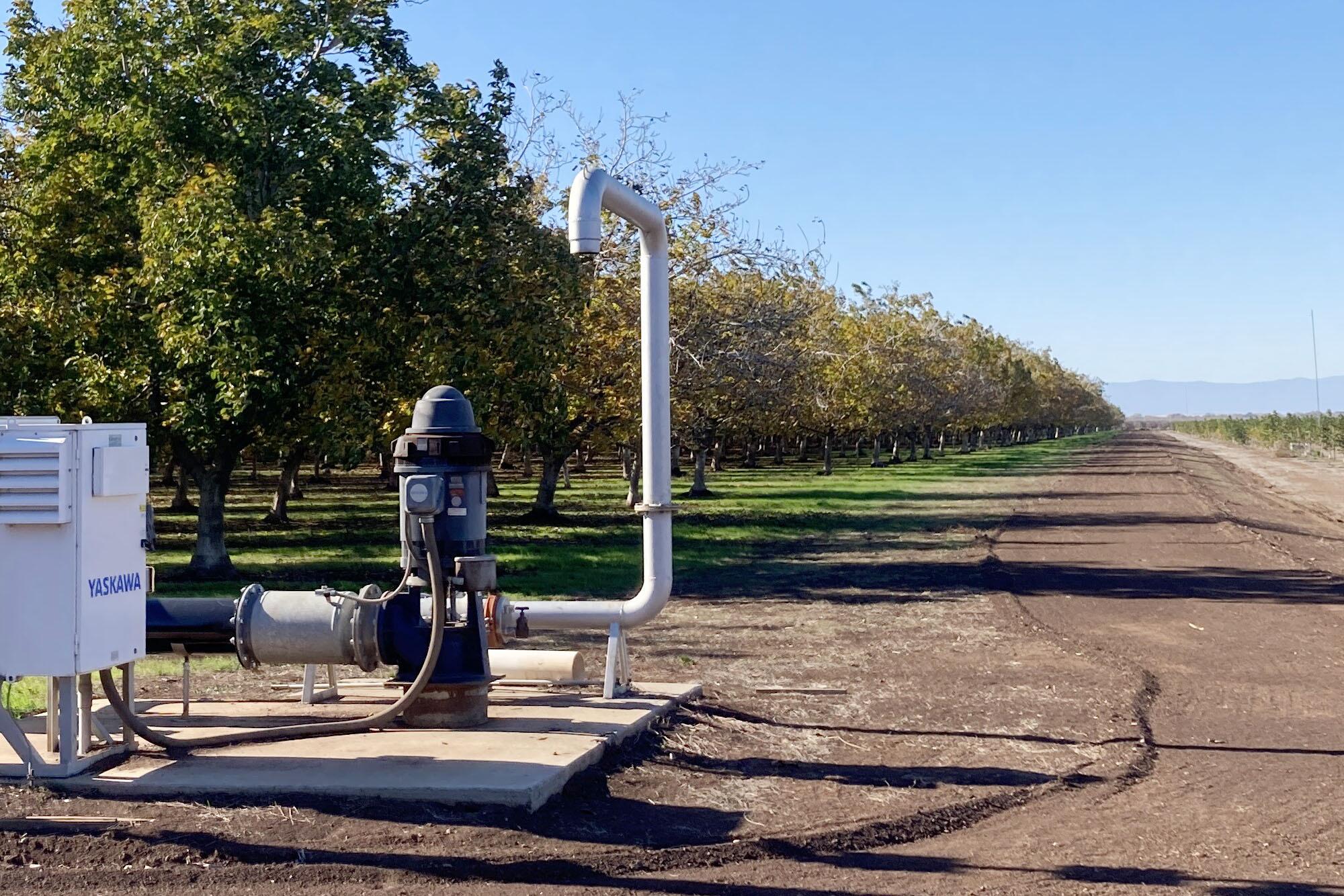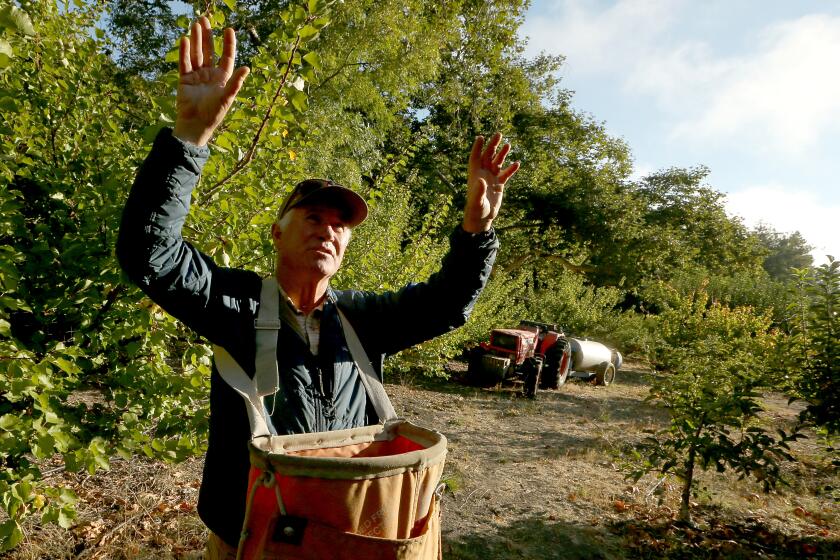
- Share via
As California grapples with worsening cycles of drought, a proposal to create a new water district in Butte County has sparked fears of a profit-driven water grab by large-scale farmers and outside interests.
In the walnut and almond orchards along State Route 99 near Chico, agricultural landowners have led a years-long campaign to form the Tuscan Water District — an entity they say is vital for the future of farming in this part of Northern California. They say having the district will enable them to bring in water and build infrastructure to recharge the groundwater aquifer.
Yet some residents argue the district would open the door to water profiteering, claiming the plan would connect local supplies to California water markets, and allow the state to demand transfers during drought emergencies.
Aggressive and impactful reporting on climate change, the environment, health and science.
The proposal, which will be decided Tuesday via mail-in balloting, has generated debate about the use of partially depleted aquifers to store imported water. Although major water suppliers in other parts of the state, such as the Metropolitan Water District of Southern California, have invested in efforts to bank water underground for times of drought, the concept has met with deep suspicion in Butte County.
“You put in the infrastructure, you start taking over the groundwater basin for private profit, and it changes everything,” said Barbara Vlamis, executive director of AquAlliance, an organization focused on protecting water resources in the Sacramento Valley. “It becomes this economic engine for these people that want to take over ownership.”
Supporters deny the charges of seeking to sell or export water. They say the district is necessary to address the local groundwater deficit and achieve sustainability in the coming years, as required under California’s Sustainable Groundwater Management Act, or SGMA.
“This is the most important development in local agriculture in a hundred years,” said Richard McGowan, a farmer who is one of the campaign’s leaders.
Local nut and fruit orchards depend entirely on groundwater, which because of overuse is projected to require reductions in pumping to meet state-mandated sustainability goals.
McGowan said the district, once formed, could plan projects to transport water to the area and use that water instead of pumping from wells, or use it to recharge the groundwater basin. Another benefit of forming the agency, he said, would be the ability to apply for government grants to fund infrastructure projects.
“We’re going to have to become sustainable,” McGowan said. “This gives us a great opportunity to work together to preserve this water resource we have. And now water has become such a hot topic, and the state has now become involved with it, that it almost dictates that we do something like this.”
California groundwater levels have risen in many areas this year, but after years of over-pumping, aquifer levels largely remain lower than two decades ago.
Those who are fighting the district say it’s unnecessary. Vlamis argued the area’s current overuse of groundwater, which is not as severe as other parts of the Central Valley, could easily be addressed through conservation, estimating that if growers would save about 5%, that would be enough.
She and others argue that if infrastructure is built to bring in water for groundwater recharge, the imported water that’s stored in the aquifer would become a privately owned asset, effectively creating a water bank. They say the groundwater basin could then be drawn down and filled with banked water, which could be sold and shipped elsewhere for profit.
Such water banks have been established by various entities elsewhere in the state, such as the southern San Joaquin Valley.
Vlamis said banking water would require a drawdown of the aquifer to create storage space, which would diminish the flow of streams, threaten groundwater-dependent trees and put shallow domestic wells at risk of running dry.
“I think it is a damaging effort that could potentially destroy this region as we know it,” Vlamis said.

Opponents formed a political action committee called Groundwater for Butte, which has warned that establishing the district is a “water grab by Big Ag and the state.”
“When they begin to pump water into the ground, from surface water that is already owned by private parties, those companies or those interests will own the water in the ground under my house,” said Jeffrey Obser, executive director of Groundwater for Butte. “That public status of the water will slowly be erased.”
Supporters of the Tuscan Water District called such claims unfounded, saying they do not intend to transfer any water out of the area — and that measures are in place to prevent that from happening.
They pointed out that the resolution outlining the district’s authority specifically states that it will not “have the powers to export, transfer, or move water” outside the local Vina and Butte subbasins, and that the district will not transfer any imported water outside its boundaries.
“That’s an important restriction,” said Tovey Giezentanner, a consultant and spokesperson for the Tuscan Water District. “It was formed without the power to export water out of the county.”
In California’s Cuyama Valley, companies pump vast amounts of water to grow carrots. When companies sued residents over water, the community launched a boycott.
Another of the conditions adopted by the Local Agency Formation Commission says the district must submit proposed projects, such as those focusing on aquifer recharge, to the local groundwater agency to ensure consistency with the area’s state-required groundwater sustainability plan.
Those conditions “will ensure that the water stays local,” Giezentanner said.
Supporters note that Butte County also has since the 1990s had an ordinance that requires a county review process for any transfers of local groundwater outside the county, or for so-called groundwater substitution transfers, in which a property owner would sell surface water that would otherwise be used locally and, as a substitute, would pump groundwater.
McGowan touted those measures, saying the effort to create the agency “is not about shipping water out of the county.”
Excessive groundwater pumping has long been depleting aquifers in California’s Central Valley. Now, scientists say the depletion is accelerating.
But Vlamis said the district’s bylaws could easily be changed to allow for water to be moved out of the area, and the county ordinance simply outlines a procedure that would have to be followed.
“Even if that’s not their intention, to transfer water out of here, all it takes is an emergency proclamation by the governor, and all local ordinances and everything are thrown out,” Vlamis said. “You may have honorable intentions, but once the state wants more water, and you’ve put in the infrastructure to facilitate this, all bets are off.”
The water district’s proposed 102,000-acre territory covers a portion of the Tuscan Aquifer around Chico. It would overlap with part of the local Vina Groundwater Sustainability Agency’s territory.
State regulators have endorsed the area’s groundwater management plans, but Vlamis’ group AquAlliance is suing to challenge the Vina plan, as well as two other local plans. The group cites various failures in the plans, saying they would allow for substantial declines in groundwater levels, threatening wells and streams.
Vlamis said she’s convinced there is a longstanding interest among state and federal water officials to “integrate” the county’s groundwater into the state’s supplies, allowing for water to be transferred out of the area.
The state Department of Water Resources denied that.
Landowners have been casting ballots in the mail-election election. The balloting is weighted based on assessed land value, so the largest landowners, some of which farm thousands of acres, will have the biggest influence in the result. Critics have objected to this type of vote, saying they believe a one-vote-per-person system would be fairer.
Some California growers specialize in dry farming, working with nature to grow apples and melons without irrigation. They tout the approach as a water solution.
Richard Harriman, a lawyer in Chico, called the effort to form the district a “Trojan Horse,” saying out-of-county landowners are seeking control of the area’s water “for purposes that are not for the public interest in Butte County.”
“It is absolute folly to think that the water is going to stay in Butte County, in that water bank, once the price of water is higher than the economic value of that water to agriculture. It will be gone. The water will follow the money,” Harriman said.
Farmer Ernie Washington said in a letter to the Chico Enterprise-Record that he initially was concerned about the potential to export water from the county.
“Conspiracy theories abound in the water world and I’m not naive enough to think that there aren’t plenty of outside interests with designs on our groundwater,” Washington wrote.
But he added that he’s satisfied measures are in place to address that “as well as it can be,” and believes the intent of those seeking to form the district is to “preserve our groundwater resource,” as well as farmers’ livelihood and way of life.














